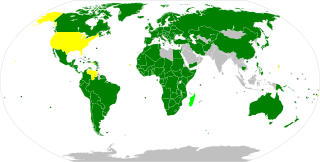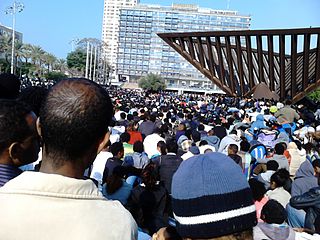Related Research Articles
An asylum seeker is a person who leaves their country of residence, enters another country and applies for asylum in that other country. An asylum seeker is an immigrant who has been forcibly displaced and might have fled their home country because of war or other factors harming them or their family. If their case is accepted, they become considered a refugee. The terms asylum seeker, refugee and illegal immigrant are often confused.
In international law, a stateless person is someone who is "not considered as a national by any state under the operation of its law". Some stateless people are also refugees. However, not all refugees are stateless, and many people who are stateless have never crossed an international border. On November 12, 2018, the United Nations High Commissioner for Refugees stated there are about 12 million stateless people in the world.
A Temporary Protection Visa (TPV) is an Australian visa category issued to persons who had been recognised as refugees fleeing persecution. TPVs are issued to persons who apply for refugee status after making an unauthorised arrival in Australia, and is the main type of visa issued to refugees when released from Australian immigration detention facilities. TPVs were initially introduced by the Howard government on 20 October 1999, abolished by the Rudd government in August 2008, reintroduced by the Abbott government in October 2013, and have continued until the present.

The Pacific Solution is the name given to the government of Australia's policy of transporting asylum seekers to detention centres on island nations in the Pacific Ocean, rather than allowing them to land on the Australian mainland. Initially implemented from 2001 to 2007, it had bipartisan support from the Coalition and Labor opposition at the time. The Pacific Solution consisted of three central strategies:

Australian immigration detention facilities comprise a number of different facilities throughout Australia, including the Australian territory of Christmas Island. Such facilities also exist in Papua New Guinea and Nauru, namely the Nauru Regional Processing Centre and the Manus Regional Processing Centre.
Refugee law is the branch of international law which deals with the rights and duties states have vis-a-vis refugees. There are differences of opinion among international law scholars as to the relationship between refugee law and international human rights law or humanitarian law.

The Australian migration zone is a legal device created by the Australian Government for the purpose of Australia's visa policy and immigration policy, as the territory in which Australia's visa policy applies. The Australian migration zone covers such Australian controlled territories as the government may determine. Prior to 2001, the Australian migration zone consisted of the mainland, as well as some external territories. Norfolk Island, for example, was not part of the Australian migration zone until 2016. Under Australia’s universal visa policy, a non-citizen must hold an Australian visa within the Australian migration zone. Without such a visa, or a bridging visa, the non-citizen is an unlawful non-citizen and treated as an "unauthorised arrival". However, the main effect of the migration zone is that unauthorised arrivals outside the zone have very limited access for review by Australian courts.

The Dublin Regulation is a European Union (EU) law that determines which EU Member State is responsible for the examination of an application for asylum, submitted by persons seeking international protection under the Geneva Convention and the EU Qualification Directive, within the European Union. It is the cornerstone of the Dublin System, which consists of the Dublin Regulation and the EURODAC Regulation, which establishes a Europe-wide fingerprinting database for unauthorised entrants to the EU. The Dublin Regulation aims to "determine rapidly the Member State responsible [for an asylum claim]" and provides for the transfer of an asylum seeker to that Member State.
The right of asylum is an ancient juridical concept, under which people persecuted by their own rulers might be protected by another sovereign authority, like a second country or another entity which in medieval times could offer sanctuary. This right was recognized by the Ancient Egyptians, the Greeks, and the Hebrews, from whom it was adopted into Western tradition. René Descartes fled to the Netherlands, Voltaire to England, and Thomas Hobbes to France, because each state offered protection to persecuted foreigners.

The Convention Relating to the Status of Refugees, also known as the 1951 Refugee Convention or the Geneva Convention of 28 July 1951 is a United Nations multilateral treaty that defines who a refugee is and sets out the rights of individuals who are granted asylum and the responsibilities of nations that grant asylum. The Convention also sets out which people do not qualify as refugees, such as war criminals. The Convention also provides for some visa-free travel for holders of refugee travel documents issued under the convention.

Illegal immigration is the migration of people into a country in violation of the immigration laws of that country or the continuous residence without the legal right to live in that country. Illegal immigration tends to be financially upward, from poorer to richer countries. Illegal residence in another country creates the risk of detention, deportation, and/or other sanctions.

The United States recognizes the right of asylum for individuals seeking protections from persecution, as specified by international and federal law. People who seek protection while outside the U.S. are termed refugees, while people who seek protection from inside the U.S. are termed asylum seekers. Those who are granted asylum are termed asylees.
The Australian government has a policy and practice of detaining in immigration detention facilities non-citizens not holding a valid visa, suspected of visa violations, illegal entry or unauthorised arrival, and those subject to deportation and removal in immigration detention until a decision is made by the immigration authorities to grant a visa and release them into the community, or to repatriate them to their country of origin/passport. Persons in immigration detention may at any time opt to voluntarily leave Australia for their country of origin, or they may be deported or given a bridging or temporary visa. In 1992, Australia adopted a mandatory detention policy obliging the government to detain all persons entering or being in the country without a valid visa, while their claim to remain in Australia is processed and security and health checks undertaken. Also, at the same time, the law was changed to permit indefinite detention, from the previous limit of 273 days. The policy was instituted by the Keating government in 1992, and has been varied by the subsequent Howard, Rudd, Gillard, Abbott, Turnbull, Morrison and Albanese Governments. The policy is regarded as controversial and has been criticised by a number of organisations. The High Court of Australia has confirmed, by majority, the constitutionality of indefinite mandatory detention of non-citizens.
The Canada–United States Safe Third Country Agreement (STCA) is a treaty, entered into force on 29 December 2004, between the governments of Canada and the United States to better manage the flow of refugee claimants at the shared land border.

African immigration to Israel is the international movement to Israel from Africa of people that are not natives or do not possess Israeli citizenship in order to settle or reside there. This phenomenon began in the second half of the 2000s, when a large number of people from Africa entered Israel, mainly through the then-lightly fenced border between Israel and Egypt in the Sinai Peninsula. According to the data of the Israeli Interior Ministry, 26,635 people arrived illegally in this way by July 2010, and over 55,000 by January 2012. In an attempt to curb the influx, Israel constructed the Egypt–Israel barrier. Since its completion in December 2013, the barrier has almost completely stopped the immigration of Africans into Israel across the Sinai border.

Illegal immigration to Canada is the act of a person who is not a Canadian citizen or permanent resident entering or remaining in Canada in a manner contrary to the Immigration and Refugee Protection Act and its associated regulations. That includes persons who entered Canada on a travel visa but remained beyond the period of stay specified as well as persons who entered Canada without presenting themselves at a port of entry.
Unaccompanied asylum-seeking children in the United Kingdom, often abbreviated to UASC, are children who are outside their country of origin to seek asylum in the United Kingdom, are separated from parents and relatives, and are not in the care of someone who is responsible for doing so.
Asylum in Australia has been granted to many refugees since 1945, when half a million Europeans displaced by World War II were given asylum. Since then, there have been periodic waves of asylum seekers from South East Asia and the Middle East, with government policy and public opinion changing over the years.
Subsidiary protection is international protection for persons seeking asylum who do not qualify as refugees. In European law, Directive 2004/83/EC defines the minimum standards for qualifying for subsidiary protection status. The Directive was later added to with Directive 2011/95/EU, which states that uniform, European states for persons eligible for subsidiary protection and the content of the protection granted.
Migration and asylum policy of the European Union - is a policy within the area of freedom, security and justice, established to develop and harmonise principles and measures used by member countries of the European Union to regulate migration processes and to manage issues concerning asylum and refugee status in the European Union, in particular in the Schengen Area.
References
- ↑ The Universal Declaration of Human Rights Article 13, Section 2